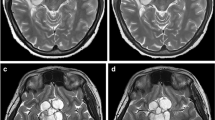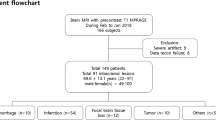Abstract
We developed a 3D version of fast fluid-attenuated inversion-recovery imaging (FLAIR) which provides images with a slice thickness of 1.5 mm. We present our initial experience with 3D fast FLAIR in patients with epilepsy. We compared 3D fast FLAIR (slice thickness 1.5 mm), 2D fast FLAIR (slice thickness 5 mm) and a 3D spoiled GRASS (IRSPGR) sequence (slice thickness 1.5 mm) in 10 patients with lesional epilepsy (head injury 1, hippocampal sclerosis 2, low-grade glioma 2, dysembryoplastic neuroepithelial tumour 2, polymicrogyria 1, perinatal infarct 1 and presumed thrombosed aneurysm 1). Both 2D and 3D fast FLAIR sequences yielded higher conspicuity for lesions than the T1-weighted IRSPGR sequence, except in the patient with polymicrogyria. The extent of the lesion, in particular that of low-grade tumours, was best assessed on 3D fast FLAIR images. 3D fast FLAIR may be a useful additional tool especially for imaging low-grade tumours.
Similar content being viewed by others
Author information
Authors and Affiliations
Additional information
Received: 22 October 1997 Accepted: 16 December 1997
Rights and permissions
About this article
Cite this article
Wieshmann, U., Barker, G., Symms, M. et al. Fast fluid-attenuated inversion-recovery imaging: first experience with a 3D version in epilepsy. Neuroradiology 40, 483–489 (1998). https://doi.org/10.1007/s002340050630
Issue Date:
DOI: https://doi.org/10.1007/s002340050630




